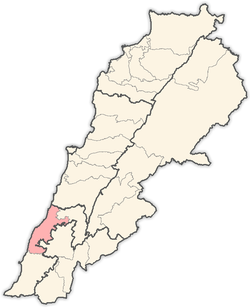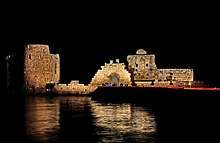Sidon District
The Sidon District (Arabic: قضاء صيدا) is a district within the South Governorate of Lebanon.
Sidon District قضاء صيدا | |
|---|---|
District | |
 Sidon coast | |
 Location in Lebanon | |
| Country | |
| Governorate | South Governorate |
| Capital | Sidon |
| Area | |
| • Total | 106 sq mi (275 km2) |
| Population | |
| • Total | 207,500 |
| Time zone | UTC+2 (EET) |
| • Summer (DST) | UTC+3 (EEST) |

Cities and towns
- Aadloun
- Ansariye
- Ghaziyeh
- Maghdouché
- Majdelyoun
- Miye ou Miye
- Qinarit
- Salhieh
- Sarepta
- Sidon - capital
- Tabbaya
- Zrarieh
- khorbet aldowier
Villages
- Ain El Delb
- Anqoun
- Darb Es Sim
- Jensnaya
- Kfar Chellal
- Kfar Hatta
- Qraiye
- Tanbourit
- Zaita
- Zaghdraiya
Oil and petroleum
Sidon serves as the Mediterranean terminus of the Trans-Arabian Pipeline, a 1,720 km (1,068.76 mi) long oil pipeline that pumps oil from the fields near Abqaiq in Saudi Arabia. The pipeline played an important role in the global trade of petroleum—helping with the economic development of Lebanon—as well as American and Middle Eastern political relations. At the time it was built in 1947, the project was considered ground-breaking and innovative with a maximum capacity of about 500,000 barrels per day (79,000 m3/d). After the 1967 Six-Day War and due to constant bickering between Saudi Arabia and Syria and Lebanon over transit fees, the emergence of oil supertankers and pipeline breakdowns, the section of the line beyond Jordan ceased operation in 1976.
The city of Sidon is the site of a large-scale oil facility constituting oil-storage tanks, an oil refinery, a thermal power plant and a fuel port. During the Lebanese civil war and the Israeli invasions, the site was bombarded several times either by Israeli war-planes or by Palestinian militia groups which lead eventually to the closure of the site. The oil tank and the refinery are in severe conditions but are now undergoing a massive rehabilitation plan put down by the Ministry of Power and Water Resources, as well as those in Tripoli in the north, to store Lebanon's future oil and natural gas supplies recently discovered offshore. For now, the facilities that still work on the site are the thermal power plant and the fuel port, which the state began to use to import oil after the pipeline ceased work in the 1970s.
Demographics
According to voter registration data, voters in the district are mostly Muslim (83%).[1]
Voters in the city of Saida (61237) are 94% Muslim:[2]
- 84% are Sunni
- 9% are Shia
- 6% are Christian (mixed between Maronite, Greek Melkite Catholic, and Armenian Orthodox).
Voters in the rest of the district (112372, called the Zahrani constituency in the 2018 electoral law) are predominantly Shia and 77% Muslim:[3]
- 74% are Shia
- 3% are Sunni
- 12% are Greek Melkite Catholic
- 10% are Maronite
Thus, there is a bigger percentage of Christian voters in the district of Saida (17%) than in Tyre (6.3%), but much less than in Jezzine (75%).